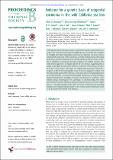Evidence for a genetic basis of urogenital carcinoma in the wild California sea lion
Abstract
Although neoplasia is a major cause of mortality in humans and domestic animals, it has rarely been described in wildlife species. One of the fewexamples is a highly prevalent urogenital carcinoma in California sea lions (CSLs). Although the aetiology of this carcinoma is clearly multifactorial, inbreeding depression, as estimated using levels of microsatellite multilocus heterozygosity, is identified as predictive for this neoplasia. On further analysis, this relationship appears to be largely driven by one marker, suggesting that a single locus might be associated with the occurrence of this disease in CSLs. In a case–control study, carcinoma was significantly associated with homozygosity at the Pv11 microsatellite locus. Pv11 was mapped to intron 9 of the heparanase 2 gene (HPSE2) locus, a very large gene encoding heparanase 2, which in humans is associated with multiple carcinomas. Correspondingly, immunohistochemical labelling in tissues was present in carcinoma cases within a single homozygous Pv11 genotype. To our knowledge, this is the first report of an individual locus being associated with cancer in any wildlife species. This adds emphasis to the study of HPSE2 in other species, including humans and will guide future studies on this sentinel species that shares much of its diet and environment with humans
Citation
Browning , H M , Acevedo-Whitehouse , K , Gulland , F M D , Hall , A J , Finlayson , J , Dagleish , M P , Billington , K J , Colegrove , K & Hammond , J A 2014 , ' Evidence for a genetic basis of urogenital carcinoma in the wild California sea lion ' , Proceedings of the Royal Society B: Biological Sciences , vol. 281 , no. 1796 , 20140240 . https://doi.org/10.1098/rspb.2014.0240
Publication
Proceedings of the Royal Society B: Biological Sciences
Status
Peer reviewed
ISSN
0962-8452Type
Journal article
Description
This work was funded by a grant from the US National Marine Fisheries Service John H. Prescott Marine Mammal Rescue Assistance grant programme, and H.M.B. was funded by a UK Natural Environment Research Council PhD studentship. J.A.H. was funded by the BBSRC Institute Strategic Programme on Livestock Viral Diseases at The Pirbright Institute.Collections
Items in the St Andrews Research Repository are protected by copyright, with all rights reserved, unless otherwise indicated.

